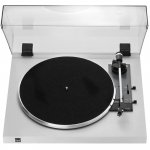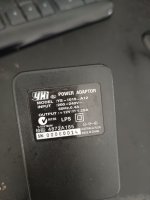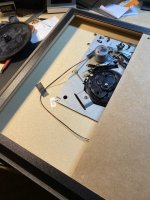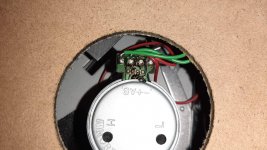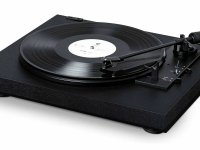Hi All.
I have a Dual CS 415-2 Turntable with missing power pack.
This model features external power pack rather than onboard.
The Dual specs for their power pack is: 12V DC, 150 mA
I picked up a non Dual Power Pack with the specs: 12V DC 1.25A
I listened to a video on power packs.
It was indicated that with mA/A values, there is a pull rather than a push.
If the power pack has greater mA/A than the end device requirement, the device will only pull what is required.
Bottom line, the turntable plays records at incorrect (slower) speed.
Do I have a power problem or is the turntable malfunctioning?
thanks C
I have a Dual CS 415-2 Turntable with missing power pack.
This model features external power pack rather than onboard.
The Dual specs for their power pack is: 12V DC, 150 mA
I picked up a non Dual Power Pack with the specs: 12V DC 1.25A
I listened to a video on power packs.
It was indicated that with mA/A values, there is a pull rather than a push.
If the power pack has greater mA/A than the end device requirement, the device will only pull what is required.
Bottom line, the turntable plays records at incorrect (slower) speed.
Do I have a power problem or is the turntable malfunctioning?
thanks C
1. Measure the actual voltage the power supply is outputting with your multimeter and report back. Check the power supply plug is centre positive.
2. Does the platter run slowly on both 45rpm and 33rpm?
If the platter is only slightly slow on one or other of the speeds, a speed adjustment is indicated.
Look for two holes in the base of the deck (they may be covered over) through which speed presets can be accessed with a fine screwdriver. Adjusting to the correct speed can be tricky though. Stand the deck up on tall supports or have it hang over the edge of a table so that you can do the deed.
You can download a strobe disc which will help you set the correct speed if you can't do it by ear.
2. Does the platter run slowly on both 45rpm and 33rpm?
If the platter is only slightly slow on one or other of the speeds, a speed adjustment is indicated.
Look for two holes in the base of the deck (they may be covered over) through which speed presets can be accessed with a fine screwdriver. Adjusting to the correct speed can be tricky though. Stand the deck up on tall supports or have it hang over the edge of a table so that you can do the deed.
You can download a strobe disc which will help you set the correct speed if you can't do it by ear.
That turntable is the most basic system for a turntable that I've seen.
Simple, cheap.
And Galu, the two holes for speed adjustment, inside the motor, a cheap cassette deck type motor.
Simple, cheap.
And Galu, the two holes for speed adjustment, inside the motor, a cheap cassette deck type motor.
For a Dual, it's a bottom of the barrel model, shame.I believe the high and low speed presets are on the motor and accessible via holes in the base plate.
Perhaps you are thinking of the earlier CS 415 turntable?
Anyway, Cliff will soon confirm or deny.
Thanks G.
The power pack has a 12.3V reading.
It's centre positive, outer negative.
I can't found literature specifying whether the Dual is centre postive??
There are indeed 2 screws at the bottom of the motor.
This area is exposed via a circular hole cut in the base board
This turntable has "DUAL made in germany" appearing at the rear.
Could it be that the "made in germany" graphics is "made in germany", and the rest chinese?
I'll have to work on the strobe procedure??
The power pack has a 12.3V reading.
It's centre positive, outer negative.
I can't found literature specifying whether the Dual is centre postive??
There are indeed 2 screws at the bottom of the motor.
This area is exposed via a circular hole cut in the base board
This turntable has "DUAL made in germany" appearing at the rear.
Could it be that the "made in germany" graphics is "made in germany", and the rest chinese?
I'll have to work on the strobe procedure??
Attachments
...measure with smartphone app.
Good suggestion re measuring the turntable speed with a smartphone app.
The screws for fine adjustments are right at the motor, accessible from bottom. "Do not be afraid to push flat screwdriver through foam…" Clockwise makes it run faster.
I refer to this post:
https://www.vinylengine.com/turntable_forum/viewtopic.php?t=70698#p567051
"It's the same thing for all CS410/415/430/435/450/455 versions (except the newer plastic CS410 from the Far East...): The motor case has got two foam-covered holes on the underside, marked with an L for 33 1/3 and an H for 45 rpm. Through these holes one has access to the corresponding trim pots for adjustment. Only one of the two is independent though, while the other one will work in parallel for the second speed, so that the adjustment needs to be done in the correct sequence: First adhust the one that's always active, then the one that is only active for the second speed. Iirc, first speed should be 33 1/3 rpm in this case.
Greetings from Munich!
Manfred / lini" < end of citation.
Cheers, Lukas
I refer to this post:
https://www.vinylengine.com/turntable_forum/viewtopic.php?t=70698#p567051
"It's the same thing for all CS410/415/430/435/450/455 versions (except the newer plastic CS410 from the Far East...): The motor case has got two foam-covered holes on the underside, marked with an L for 33 1/3 and an H for 45 rpm. Through these holes one has access to the corresponding trim pots for adjustment. Only one of the two is independent though, while the other one will work in parallel for the second speed, so that the adjustment needs to be done in the correct sequence: First adhust the one that's always active, then the one that is only active for the second speed. Iirc, first speed should be 33 1/3 rpm in this case.
Greetings from Munich!
Manfred / lini" < end of citation.
Cheers, Lukas
Attachments
Actually, it's a BAD suggestion.
Those apps are notorious for being innaccurate, plus the weight of the phone adds unbalanced mass to the platter as in your photo.
Those apps are the stupidest thing to use, get real, and use a proper stobe DISK of paper (easily printed) or a commercial plastic DISK, with a neon or other line-operated incandescent lamp.
Yep, see?.... another chinese hunk of garbage from a "once respected" manufacturerer.The screws for fine adjustments are right at the motor, accessible from bottom. "Do not be afraid to push flat screwdriver through foam…" Clockwise makes it run faster.
I refer to this post:
https://www.vinylengine.com/turntable_forum/viewtopic.php?t=70698#p567051
"It's the same thing for all CS410/415/430/435/450/455 versions (except the newer plastic CS410 from the Far East...): The motor case has got two foam-covered holes on the underside, marked with an L for 33 1/3 and an H for 45 rpm. Through these holes one has access to the corresponding trim pots for adjustment. Only one of the two is independent though, while the other one will work in parallel for the second speed, so that the adjustment needs to be done in the correct sequence: First adhust the one that's always active, then the one that is only active for the second speed. Iirc, first speed should be 33 1/3 rpm in this case.
Greetings from Munich!
Manfred / lini" < end of citation.
Cheers, Lukas
A glorified Crosley, labeled as a Dual.
...these apps are only for a baseline average reading only
One can buy an RPM app for $15 (free trial available, apparently).
Recently, Hi-Fi World measured the speed of an Audio Technica AT LPW30 fitted with a dc servo-motor from China.
Compared to a + 0.50% fast figure from a wow & flutter meter (reading a DIN 45 545 test LP), the RPM app gave a figure of + 0.62%.
You must calibrate RPM first (it self-calibrates) and use longest average for such accuracy.
Adusting the AT LPW30's speed to +/-0.15% was do-able and that was considered more than good enough.
Why? Because around 1% error, slow or fast, is considered maximum before pitch error can be detected.
I see that the new Pro-Ject Automat A1 turntable uses the same mechanism as that on the Dual CS415-2.
"The development has been made possible through a new partnership agreement with Fehrenbacher GmbH in St Georgen, Germany (the production facility of the original 20th-century Dual turntables), allowing the Automat range to benefit from proven made-in-Europe automatic drive technologies."
"The development has been made possible through a new partnership agreement with Fehrenbacher GmbH in St Georgen, Germany (the production facility of the original 20th-century Dual turntables), allowing the Automat range to benefit from proven made-in-Europe automatic drive technologies."
Attachments
Yep, see?.... another chinese hunk of garbage from a "once respected" manufacturerer.
See above.
Yes, I see.See above.
It's the "way of the world" these days to make such sub-standard sloppy products.
AND jack up the prices of said slop to make people think: "Oh, it's a Dual!.... must be good!"
Thorens tables (lower end) were made by Dual in Eastern Europe, possibly Czechoslovakia.
It's all in the name....
It's all in the name....
They also said:I see that the new Pro-Ject Automat A1 turntable uses the same mechanism as that on the Dual CS415-2.
"The development has been made possible through a new partnership agreement with Fehrenbacher GmbH in St Georgen, Germany (the production facility of the original 20th-century Dual turntables), allowing the Automat range to benefit from proven made-in-Europe automatic drive technologies."
Quote: After years of research and development, Pro-Ject Audio Systems are thrilled to announce their very first automatic turntable.
How does years of research & development equate to buying the Dual design?
- Home
- Source & Line
- Analogue Source
- Power Pack for Dual CS 415-2 Turntable?
